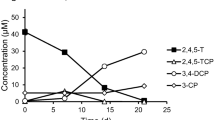Abstract
An anaerobic enrichment culture with glucose as the sole source of carbon and energy plus trichloroethene (TCE) as a potential electron acceptor was inoculated with material from a full size anaerobic charcoal reactor that biologically eliminated dichloromethane from contaminated groundwater (Stromeyer et al. 1991). In subcultures of this enrichment complete sequential transformation of 10 µM TCE viacis-dichloroethene and chloroethene to ethene was reproducibly observed. Maintenance of this activity on subcultivation required the presence of TCE in the medium. The enrichment culture was used to inoculate an anaerobic fixed-bed reactor containing sintered glass Raschig elements as support material. The reactor had a total volume of 1780 ml and was operated at 20 °C in an up-flow mode with a flow rate of 50 ml/h. It was fed continuously with 2 mM glucose and 55 µM TCE. Glucose was converted to acetate as the major product and to a minor amount of methane; TCE was quantitatively dehalogenated to ethene. When, in addition to TCE, tetrachloroethene or 1,2-dichloroethane were added to the system, these compounds were also dehalogenated to ethene. In contrast, 1,1,1-trichloroethane was not dehalogenated, but at 40 µM severely inhibited acetogenesis and methanogenesis. When the concentration of TCE in the feed was raised to 220 µM, chloroethene transiently accumulated, but after an adaptation period ethene was again the only volatile product detected in the effluent. The volumetric degradation rate at this stage amounted to 6.2 µmol/l/h. Since complete transformation of TCE occurred in the first sixth of the reactor volume, the degradation capacity of the system is estimated to exceed this value by factor of about ten.
Similar content being viewed by others
Abbreviations
- CA:
-
chloroethane
- 1,1-DCA:
-
1,1-dichloroethane
- 1,2-DCA:
-
1,2-dichloroethane
- 1,1-DCE:
-
1,1-dichloroethene
- c-DCE:
-
cis-1,2-dichloroethene
- t-DCE:
-
trans-1,2-dichloroethene
- PCE:
-
tetrachloroethene, perchloroethene
- 1,1,1-TCA:
-
1,1,1-trichloroethane
- TCE:
-
trichloroethene
- VC:
-
chloroethene, vinyl chloride
References
Belay N & Daniels L (1987) Production of ethane, ethylene and acetylene from halogenated hydrocarbons by methanogenic bacteria. Appl. Environ. Microbiol. 53: 1604–1610
Buswell AM & Symons GE (1933) The methane fermentation of carbohydrates. J. Am. Chem. Soc. 55: 2028–2036
De Bruin WP, Kotterman MJJ, Posthumus MA, Schraa G & Zehnder AJB (1992) Complete biological transformation of tetrachloroethene to ethane. Appl. Environ. Microbiol. 58: 1996–2000
DiStefano TD, Gossett JM & Zinder SH (1991) Reductive dechlorination of high concentrations of tetrachloroethene to ethene by an anaerobic enrichment culture in the absence of methanogenesis. Appl. Environ. Microbiol. 57: 2287–2292
Easter MD & Von Burg R (1994) Toxicology update, vinyl chloride. J. Appl. Toxicol. 14: 301–307
Egli C, Scholtz R, Cook AM & Leisinger T (1987) Anaerobic dechlorination of tetrachloromethane and 1,2-dichloroethane to degradable products by pure cultures ofDesulfobacterium sp. andMethanobacterium sp. FEMS Microbiol. Lett. 43: 257–261
Eichler B & Pfennig N (1986) Characterization of a new plateletforming purple sulfur bacterium,Amoebobacter pedioformis sp. nov. Arch. Microbiol. 146: 295–300
Ensley BD & Kurisko PR (1994) A gas lift bioreactor for removal of contaminants from the vapor phase. Appl. Environ. Microbiol. 60: 285–290
Ensley BD (1991) Biochemical diversity of trichloroethylene metabolism. Annu. Rev. Microbiol. 45: 283–299
Fennell DE, Nelson YM, Underhill SE, White TE & Jewell JW (1993) TCE degradation in a methanotrophic attached-film bioreactor. Biotechnol. Bioeng. 42: 859–872
Folsom BR & Chapman PJ (1991) Performance characterization of a model bioreactor for the biodegradation of trichloroethylene bypseudomonas cepacia G4. Appl. Environ. Microbiol. 57: 1602–1608
Freedman DL & Gossett JM (1989) Biological reductive dechlorination of tetrachloroethylene and trichloroethylene to ethylene under methanogenic conditions. Appl. Environ. Microbiol. 55: 2144–2151
Gälli R & McCarty PL (1989) Kinetics of biotransformation of 1,1,1-trichloroethane byClostridium sp. strain TCAIIB. Appl. Environ. Microbiol. 55: 845–851
Heijnen JJ & van Dijken JP (1992) In search of a thermodynamic description of biomass yields for the chemotrophic growth of microorganisms. Biotechnol. Bioeng. 39: 833–858
Holliger C, Kengen SWM, Schraa G, Stams AJM & Zehnder AJB (1992) Methyl-coenzyme M reductase ofMethanobacterium thermoautotrophicum ΔH catalyzes the reductive dechlorination of 1,2-dichloroethane to ethylene and chloroethane. J. Bacteriol. 174: 4435–4443
Holliger C, Schraa G, Stams AJM & Zehnder AJB (1990) Reductive dechlorination of 1,2-dichloroethane and chloroethane by cell suspensions of methanogenic bacteria. Biodegradation 1: 253–261
—— (1993) A highly purified enrichment culture couples the reductive dechlorination of tetrachloroethene to growth. Appl. Environ. Microbiol. 59: 2991–2997
Hopkins GD, Semprini L & McCarty PL (1993) Microcosm and in situ field studies of enhanced biotransformation of trichloroethylene by phenol-utilizing microorganisms. Appl. Environ. Microbiol. 59: 2277–2285
Howard PH (1990) Handbook of environmental fate and exposure data for organic chemicals. Vol 3 (pp 467–473) Lewis Publishers Inc. Michigan
Neumann A, Scholz-Muramatsu H & Dieckert G (1994) Tetrachloroethene dechlorination to cis-1,2-dichloroethene in cell suspensions and cell extracts ofDehalospirillum multivorans Spec. nov. Poster, VAAM Frühjahrstagung in Hannover
Shahin MM & Von Borstel RC (1977) Mutagenic and lethal effects of α-benzene hexachloride, dibutyl phthalate and trichloroethylene inSaccharomyces cerevisiae. Mutat. Res. 48: 173–180
Stromeyer SA, Winkelbauer W, Kohler H, Cook AM & Leisinger T (1991) Dichloromethane utilized by an anaerobie mixed culture: acetogenesis and methanogenesis. Biodegradation 2: 129–137
Van Duuren BL & Banerjee S (1976) Covalent interaction of metabolites of the carcinogen trichloroethylene in rat hepatic microsomes. Cancer Res. 36: 2419–2422
Vargas C & Ahlert RC (1987) Anaerobic degradation of chlorinated solvents. Res. J. Water Pollut. Control Fed. 59: 964–968
Vogel TM & McCarty PL (1987) Abiotic and biotic transformations of 1,1,1-trichloroethane under methanogenic conditions. Environ. Sci. Technol. 21: 1208–1213
Widdel F & Pfennig N (1981) Studies on dissimilatory sulfate-reducing bacteria that decompose fatty acids. Arch. Microbiol. 129: 395–400
Winkelbauer W & Kohler H (1991) Biologischer Abbau von Dichlormethan unter anaeroben Bedingungen in einer Aktivkohle-Anlage. GWF, Gas Wasserfach: Wasser/Abwasser 132: 425–432
Author information
Authors and Affiliations
Rights and permissions
About this article
Cite this article
Wild, A.P., Winkelbauer, W. & Leisinger, T. Anaerobic dechlorination of trichloroethene, tetrachloroethene and 1,2-dichloroethane by an acetogenic mixed culture in a fixed-bed reactor. Biodegradation 6, 309–318 (1995). https://doi.org/10.1007/BF00695261
Accepted:
Issue Date:
DOI: https://doi.org/10.1007/BF00695261




